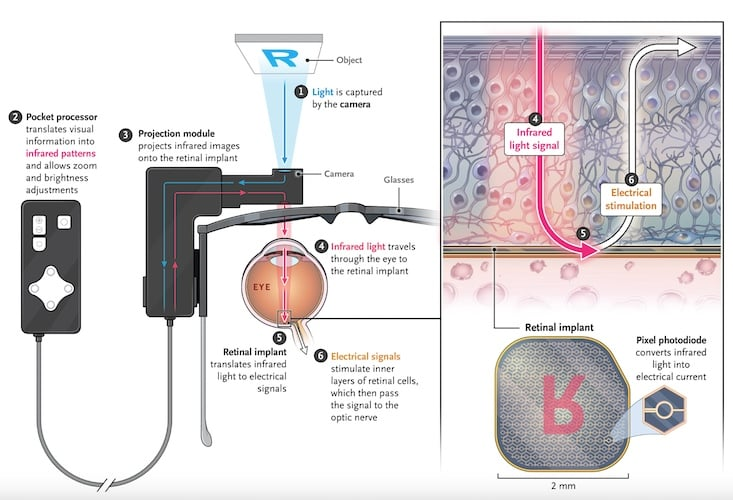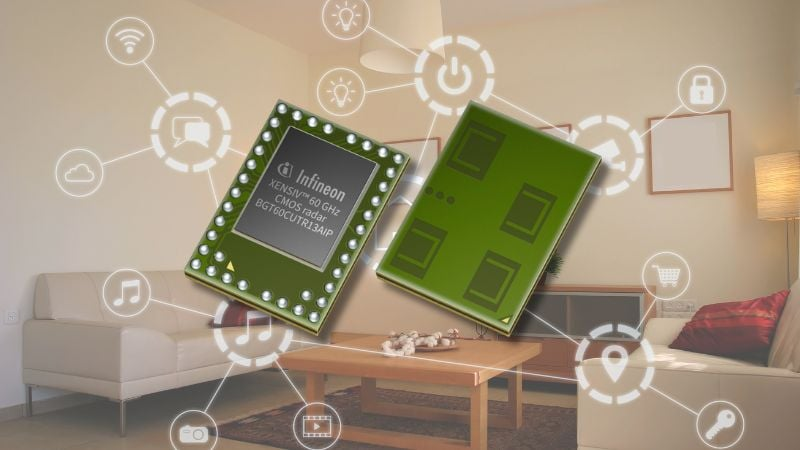Researchers in Europe have restored reading vision to people with dry age-related macular degeneration using a retinal implant and AR glasses.
For millions living with advanced dry age-related macular degeneration (AMD), losing the ability to read or recognize faces can slowly erode a person’s independence. Traditional treatments can slow the disease but not reverse the damage once the central retina dies off. Until now, there’s never been a reliable way to restore this type of lost vision.

A patient wearing augmented-reality glasses uses the PRIMA vision system to read text.
That may be changing. A European clinical trial led by researchers from University College London and Moorfields Eye Hospital has shown that an ultra-thin retinal implant, called the PRIMA system, can restore central sight to people who had gone completely blind in one eye. Eighty-four percent of participants regained the ability to recognize letters, numbers, and words—a huge milestone that researchers are calling the start of a new era in prosthetic vision.
How the “Solar-Powered Retina” Works
The PRIMA implant is essentially a wireless, photovoltaic microchip that functions like a miniature solar panel. It’s 2 mm across, about the size of a grain of rice, and only 30 microns thick, making it thinner than a human hair. Surgeons insert it beneath the retina, into the layer where photoreceptor cells have died off. Once it’s in place, the chip takes over the job those lost cells used to perform: converting light into electrical signals that the brain can interpret as vision.

The PRIMA implant, a 2-mm microchip thinner than a human hair, is positioned beneath the retina where it replaces damaged photoreceptors by converting light into electrical signals.
But the chip doesn’t work alone. Patients also wear a pair of augmented-reality glasses equipped with a tiny video camera. The camera captures the surrounding scene and sends it to a pocket-sized computer worn on the hip. There, artificial intelligence algorithms process the images in real time, filtering and simplifying the data before projecting it back into the eye as an invisible infrared signal. The PRIMA implant detects that signal, converts it into electrical impulses, and transmits it to the optic nerve, effectively tricking the brain into “seeing” again.
A Return to Reading
It’s one thing to restore basic light sensitivity, but the trial went a step further. Participants who had lost all central vision were able to read five lines of a vision chart on average after rehabilitation. Before surgery, most patients were unable to even locate the chart. Using the zoom feature on their AR glasses, patients could magnify and scan text, learning over time to interpret the artificial visual signals as readable patterns.

Path of visual information through the PRIMA system.
The PRIMA system was designed not to interfere with existing peripheral vision, and it can be adjusted to focus on fine details or broader shapes. One participant described being able to read prescriptions again, a life-changing task that relies on precise central vision. Others reported successfully navigating busy environments like subways and shopping aisles, using their new “digital vision” for both reading and movement.
Promising Early Results
In clinical data provided by The New England Journal of Medicine, the PRIMA implant demonstrated a significant improvement in visual acuity for 81% of patients one year after implantation. Importantly, no serious long-term side effects or peripheral vision losses were reported. Most surgery-related complications resolved within two months.
While the device currently restores relatively low-resolution vision, researchers see it as a foundation for something far more capable. The system’s architecture is a retinal chip paired with external processing through AR and AI, which allows the system to be upgraded over time as imaging algorithms improve and chip fabrication enables higher pixel density. The fact that it runs entirely wirelessly and can be implanted in under two hours makes it realistic for wider adoption once it receives regulatory approval.
What Comes Next?
The PRIMA system, developed by Science Corporation, represents a major step in bridging neural engineering and clinical ophthalmology. Its success also opens the door for similar devices to tackle other retinal conditions and perhaps even neurological vision loss in the near future. As one patient described it, learning to see again isn’t instant, but with this technology, this skill can return with time and practice.
All images used courtesy of UCL.



